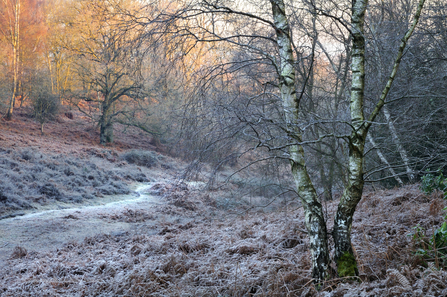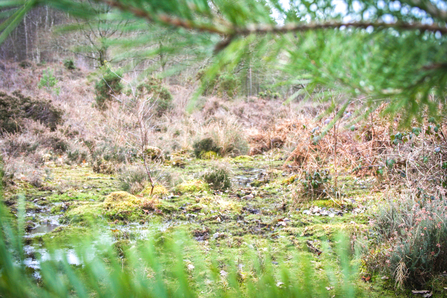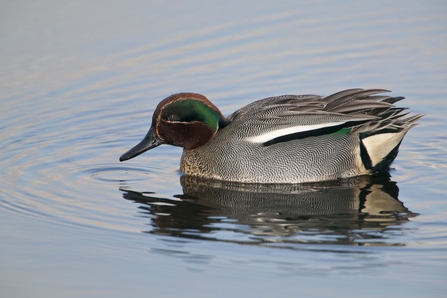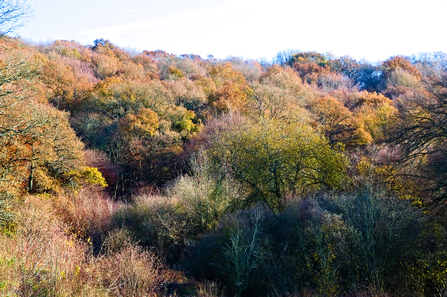
Bowdown Woods in winter. Photo by Rob Appleby
Zsuzsanna Bird

Bowdown Woods in winter. Photo by Rob Appleby
This nature reserve has three areas - Bowdown, Bomb Site and Baynes, all with a different character perfect for exploring on a winter walk.
The Bomb Site is so named because it was an ammunition store during and after the Second World War. It is a great example of how nature can thrive and develop on a site vacated by people. Many old surfaced tracks create a network through the young birch and oak woodland that has colonised the site. Try the short Wildlife Walk from the car park - it's on old surfaced tracks and ideal for less mobile visitors.
Bowdown is magical, dense ancient woodland, which has views across the Kennet Valley. The Wildlife Walk here takes in some damp clay areas on the lower slopes and steep climbs up to higher, drier ground.
Finally, Baynes is the most secretive part of the wood. The dense ancient woodland here has lots of streams and some steep paths.
Access
Baynes: steep slopes, uneven underfoot, long flight of steps and a boardwalk.
Bomb Site: flat and surfaced, accessible for robust mobility scooters and robust wheelchairs.
Bowdown: gentle slopes, soft after rain.
You can explore the reserve and wider countryside around Bowdown Woods on our 6-mile circular walk.

Bittern by Tim Stenton
This tranquil Buckinghamshire reserve is a delightful place to watch wintering wildfowl such as mallard, tufted duck and pochard.
Its large 'lake' was created by clay extraction for the brick industry. Later, part of the site was a municipal rubbish tip. Steep banks were carefully sculpted to form shallows in front of two bird hides while the creation of floating raft islands has enabled common terns and waterfowl to nest away from local foxes.
At this time of year, a lucky birdwatcher might see bittern, smew, goldeneye, and goosander. Let us know what you spot!
Access: Flat; mostly bumpy but there is a flat, surfaced path leading to the hide; gate, steps, bridges.

Red kite in flight. Photo ©David Tipling/2020VISION
Stroll along the River Thames from Goring-on-Thames to reach Hartslock nature reserve (as long as the river's not too high, alternatively walk carefully along the road). The magnificent views from the reserve stretch out over Goring Gap and the winding River Thames, and are worth the climb up the hill! Look out for red kites soaring over head or redwings feeding in the hedgerows.
You might come across some of our sheep here, which are doing an important job of grazing the land. Please leave them in peace and don't try to feed or touch them.
Access: Steep slopes, firm paths; long flight of steps

Nightjar nesting habitat at Snelsmore Common. Picture: Pete Hughes
Snelsmore Common contains a range of habitats including heathland, wet mires and woodland. There are several waymarked routes to help you explore the reserve. Perfect for a festive stroll.
Print our children's crayon rubbing trail and take it with you when you visit to discover more about the special heathland wildlife here and keep the family entertained while you walk. This follows the route of the Easy Access Trail.
Access: The common is dissected by a number of valley mires so some paths are steep and uneven. A paved circular path 0.75 miles, the Easy Access Trail, is fully accessible by pushchairs and wheelchairs (RADAR key required to fully open gate).

©Guy Edwardes/2020VISION
The Upper Ray Meadows nature reserve is a large expanse of floodplain meadows on the Bucks/Oxon border. The Gallows Bridge Farm area has bird hides overlooking the scrapes and wet meadow. This year we've been improving this area with more scrapes and pools.
During the winter months, look out for wigeon, teal, golden plover, snipe, fieldfare and short-eared owl.
Access: Flat; uneven ground, floods in winter; soft after rain; gates. Gallows Bridge Farm bird hides are accessible with a robust wheelchair. See the reserve page for full parking information for the different areas of the site.

The woodland at Warburg Nature Reserve in winter. Photo by Kaya Saman
High up in the Chilterns Area of Outstanding Natural Beauty, Warburg Nature Reserve is a remote and magnificent place, rich in exciting plants and animals all through the year.
In autumn and winter, look out for fungi growing here. An incredible 900 species have been recorded at the reserve. Overhead, red kites and buzzards fly searching for food and the woods are alive with the sound of smaller birds flitting amongst the trees.
Access: Variable, mostly steep paths and loose flint, flat grassy path; muddy in valley bottom after rain; benches.
A mobility Tramper vehicle may be available to borrow. Please email warburg@bbowt.org.uk with details of when you would like to use the Tramper. Alternatively, phone 07541 690655. The Tramper can be used from 9am-5pm seven days a week but is subject to staff availability.